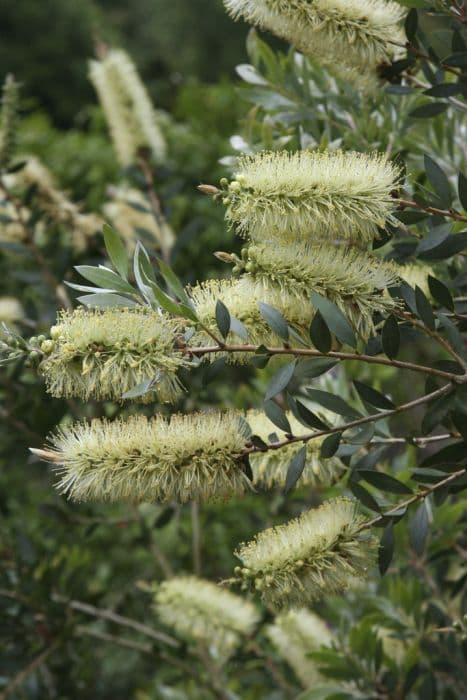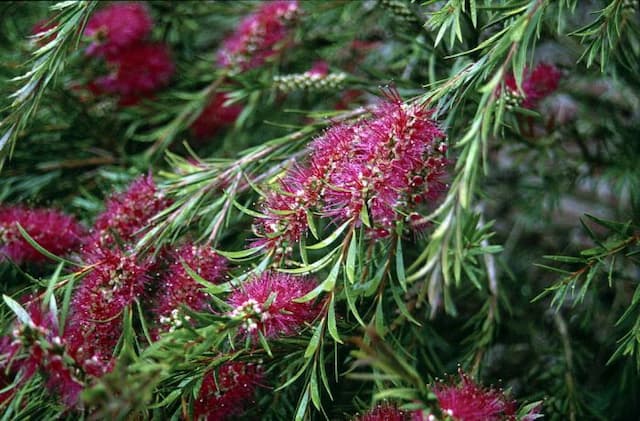Bottlebrush Callistemon 'Perth Pink'

ABOUT
Callistemon 'Perth Pink', commonly known as the Pink Bottlebrush, is a striking plant that catches the eye with its unique and vivid floral displays. Its most distinctive feature is the brush-like flowers in a vibrant shade of pink, which resemble the shape of a bottle brush. These blossoms are composed of numerous individual filaments, giving them a soft, fluffy appearance that bees and hummingbirds find irresistible. The foliage of the Pink Bottlebrush is equally attractive, boasting narrow, lance-shaped leaves that usually have a crisp, dark green color. These leaves are arranged in a spiraled fashion along the stems, giving the plant a dense and lush look. New growth often displays a reddish tint, adding to the plant's visual appeal. In addition to its floral and foliar beauty, Pink Bottlebrush also has a rugged, woody bark that brings a touch of rustic charm. This combination of elements — the spectacular pink flowers, the verdant leaves, and the textured bark — makes the Pink Bottlebrush a popular choice for gardeners looking to add a splash of color and interest to their landscaping. The bright flowers not only beautify the environment but also serve as a nectar source for various pollinators, making this plant as ecologically valuable as it is aesthetically pleasing.
About this plant
 Names
NamesSynonyms
Perth Pink Bottlebrush, Pink Bottlebrush
Common names
Callistemon 'Perth Pink'.
 Toxicity
ToxicityTo humans
Bottlebrush (Callistemon 'Perth Pink') is not widely recognized as a poisonous plant to humans. There is generally little to no concern regarding its toxicity when it comes in contact with skin or is ingested in small quantities. However, as with many plants, individual allergies or sensitivities can exist, and ingesting plant parts in large amounts may cause gastrointestinal discomfort or more serious health issues. It is always best to avoid eating ornamental plants.
To pets
Bottlebrush (Callistemon 'Perth Pink') is generally not considered toxic to pets. However, some animals may have sensitivities or allergies to plant materials. Ingesting significant quantities of the plant could potentially cause mild gastrointestinal upset in pets, such as vomiting or diarrhea. It is advisable to prevent pets from consuming ornamental plants and monitor them for any signs of distress after ingestion.
 Characteristics
CharacteristicsLife cycle
Perennials
Foliage type
Evergreen
Color of leaves
Green
Flower color
Pink
Height
6-10 feet (1.8-3 meters)
Spread
4-6 feet (1.2-1.8 meters)
Plant type
Shrub
Hardiness zones
9
Native area
Australia
Benefits
 General Benefits
General Benefits- Attracts Wildlife: The vibrant flowers of the Bottlebrush provide nectar, which attracts birds, bees, and butterflies, thus supporting biodiversity.
- Landscape Aesthetics: With its bright pink blooms, it adds a splash of color and visual interest to gardens and landscapes.
- Drought Tolerance: Once established, the Bottlebrush is fairly drought-resistant, making it suitable for regions with water scarcity.
- Erosion Control: It can help stabilize soil and control erosion due to its root system, especially on slopes or banks.
- Low Maintenance: This plant generally requires minimal care once established, making it ideal for gardeners seeking low-maintenance options.
- Adaptability: It is adaptable to a range of soil types, although it prefers well-drained conditions.
- Wind Resistance: With its sturdy structure, the Bottlebrush can endure and provide shelter from strong winds.
 Medical Properties
Medical PropertiesThis plant is not used for medical purposes.
 Air-purifying Qualities
Air-purifying QualitiesThis plant is not specifically known for air purifying qualities.
 Other Uses
Other Uses- The bottlebrush plant can be used as a natural dye source. The flowers may produce pink or red hues suitable for dyeing fabrics or materials.
- It can serve as a privacy screen when planted in a dense row, thanks to its bushy growth habit.
- The wood from the bottlebrush plant can be used for small woodworking projects, such as crafting picture frames or decorative items.
- Its distinctive flowers can be used for botanical art or printing by pressing them onto paper or fabric for natural patterns.
- Bird-watchers might cultivate bottlebrush to attract a variety of birds, including hummingbirds, that come to feed on the nectar.
- When planted along slopes or banks, the bottlebrush's root system can help control soil erosion.
- Bottlebrush branches can be incorporated in floral arrangements for a touch of unique texture and color.
- Leaves and flowers of the bottlebrush can be simmered to create fragrant potpourri or natural room scents.
- Bottlebrush flowers can be used as edible decorations for cakes and desserts, although they should be used sparingly and only when confirmed to be pesticide-free.
- This plant can be encouraged to grow into fascinating shapes, such as arches or tunnels, when used in topiary gardens or whimsical landscape designs.
Interesting Facts
 Feng Shui
Feng ShuiThe plant name for Callistemon 'Perth Pink' is Bottlebrush, and it is not commonly mentioned in traditional Feng Shui practice.
 Zodiac Sign Compitability
Zodiac Sign CompitabilityThe Bottlebrush is not used in astrology practice.
 Plant Symbolism
Plant Symbolism- Renewal - The Callistemon, commonly known as the Bottlebrush, often symbolizes renewal due to its vibrant re-blooming and resilience.
- Protection - In some cultures, Bottlebrush plants are considered to offer protection because of their hardy nature, protecting the ecosystems they inhabit.
- Healing - The Bottlebrush's colorful flowers and presence in medicinal remedies can represent healing and recuperation.
- Openness - The flower's unique shape, resembling a brush, can symbolize an openness to the experiences of life, suggesting a welcoming of diverse thoughts and emotions.
- Strength - Bottlebrush plants are known for their ability to withstand tough conditions, often symbolizing the strength to endure challenging situations.
 Water
WaterThe Bottlebrush 'Perth Pink' prefers consistent moisture but doesn't like to be waterlogged. Initially, water the plant deeply once a week to help establish roots. In the absence of rainfall, provide about 1-1.5 gallons of water per week for a newly planted shrub. As it matures, water it less frequently; established Bottlebrush 'Perth Pink' plants can tolerate some drought and will require water every two to three weeks, possibly more often in extremely hot temperatures.
 Light
LightThe Bottlebrush 'Perth Pink' thrives in full sun to partial shade. It should receive at least 6 hours of direct sunlight per day for optimal flowering. An ideal spot would be where the plant is exposed to morning sunlight and gets some afternoon shade, especially in regions with very hot summers.
 Temperature
TemperatureThe Bottlebrush 'Perth Pink' can survive in a temperature range of 20°F to 100°F. However, it thrives best in temperatures between 40°F and 90°F. Frost can damage the plant if it is prolonged or severe, so it's ideal to avoid exposure to the coldest extremes in this range.
 Pruning
PruningPruning the Bottlebrush 'Perth Pink' is done to maintain shape, remove dead or diseased branches, and encourage bushier growth and more vibrant flowering. Prune the plant after it finishes blooming, which is typically in late spring or early summer. Avoid heavy pruning in fall as this can remove buds set for the next season's flowers.
 Cleaning
CleaningAs needed
 Soil
SoilBottlebrush 'Perth Pink' thrives in well-draining, slightly acidic to neutral soil with a pH of 6.0 to 7.0. A good mix can be created using equal parts loam, sand, and peat for optimal growth and drainage. Regular mulching helps maintain soil moisture and health.
 Repotting
RepottingBottlebrush 'Perth Pink' should be repotted every 2-3 years to encourage healthy growth. It’s best to repot in spring before new growth begins, using fresh potting mix and a slightly larger pot to accommodate root development.
 Humidity & Misting
Humidity & MistingBottlebrush 'Perth Pink' prefers moderate humidity but can adapt to lower levels. They don’t require the high humidity levels that tropical plants do, making them well-suited to typical indoor environments.
 Suitable locations
Suitable locationsIndoor
Place Bottlebrush 'Perth Pink' in bright, indirect light and water when dry.
Outdoor
Plant Bottlebrush 'Perth Pink' in full sun and protect from strong winds.
Hardiness zone
8-11 USDA
 Life cycle
Life cycleThe Bottlebrush 'Perth Pink' begins its life cycle when a seed germinates, typically in warm, moist soil conditions. Upon germination, the seedling emerges, characterized by its initial set of leaves (cotyledons) and begins to develop roots and true leaves. As the plant grows, it enters the vegetative stage, during which it develops a robust root system, foliage, and stems; this period may last for several months to a few years, depending on environmental factors and care provided. After reaching maturity, the Bottlebrush 'Perth Pink' produces distinctive pink flowers, typically in spring or summer, signifying the beginning of its reproductive stage, during which pollination by birds, insects, or wind can occur. Following successful pollination, the flowers will develop into woody capsules that contain numerous small seeds. Finally, as the plant ages, it may undergo a period of decline in which growth slows and it may eventually perish, completing its life cycle with the possibility of leaving behind seeds that can give rise to new plants.
 Propogation
PropogationPropogation time
Spring-Early Summer
The ideal time for propagating the Callistemon 'Perth Pink', commonly known as Pink Bottlebrush, is during the warmer months, typically late spring through early summer. The most popular method for propagating Pink Bottlebrush is by semi-hardwood cuttings. To do this, a healthy, semi-hardwood stem of about 4 to 6 inches (10 to 15 centimeters) long is selected. The lower leaves are stripped off, and the base of the cutting is dipped in rooting hormone to encourage root development. The cutting is then planted in a well-draining potting mix and kept moist until roots have developed, which usually takes a few weeks. A plastic cover or propagation dome can help maintain humidity levels during this period. Once rooted, the cutting can be transferred to a larger pot or planted directly into the garden.









![New Zealand myrtle [Black Pearl]](/_next/image?url=https%3A%2F%2Fplants-admin.emdemapps.com%2Fimages%2Fplants%2F%2Fimages%2F604b53688d37e.png&w=640&q=75)